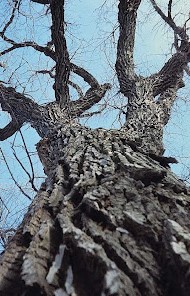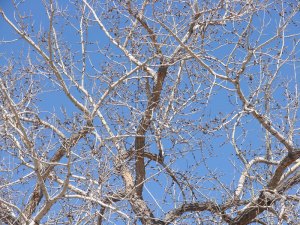With the holidays behind us, we have officially entered winter’s long stretch run. Cold snaps make getting outdoors an exercise in stoicism. Snow storms render the world in grayscale, the same world that in three months will blow up in technicolor with spring ephemerals, budbreak, and the lush green of early spring.

Two months ago I was eating Thanksgiving dinner with my family. In another two months I’ll be watching nature’s clockwork replace dead leaf litter with hepatica, hepatica with bellwort, and bellwort with mayapples to be pushed aside in search of morels hiding underneath.
Those spots on the calendar don’t feel equidistant. The calendar lies about February; it only tallies 28 days but we all feel it’s much more than that. Especially for the botanically curious, this time of year sees us feasting on our fat reserves, cracking open field guides and attending winter seminars and looking at pictures of springs past to try to feed the anxious parts of our soul.
But with the right approach, there is real and meaningful botanical joy to be found this time of year. In some circles this is called “habitat season,” a time when the narrow windows of growing season give way to a long dormancy where a given treatment will likely work equally well in December as February.

Walk in the woods with a forester in midwinter, and you could be convinced this is actually the best time to observe tree species. After all, the trees are still there, alive as ever, with next year’s growth anxiously waiting along the twigs.

To the forester, looking at bud arrangements, twig characteristics, and bark becomes second nature. Leaf morphology is great, but trees don’t read field guides. The leaf in the book might not look quite like the leaf in this tree. Not to mention, in a mature forest those leaves might rustle 50 or 100 feet up in the canopy, comingled with a half-dozen neighbors all sneaking in find a bit of sunshine.
In winter, the buds provide a more consistent cue, and each species' individuality stands out in silhouette against the sky behind. The stubby twigs of black walnut, with fuzzy gray buds above a distinctive “monkey face” leaf scar.

The mustard-yellow buds of bitternut hickory, gently curved, make it easily distinguished from young specimens of its cousin the shagbark with its supple, pale buds.

The smooth upper bark and deeply furrowed lower sections of cottonwood, signaling an early successional forest with a recent history of disturbance.
The blunt, clustered terminal buds on thick twigs of oaks, often holding their marcescent leaves deep into the winter season.

The layer-cake bark of American elm, with pointed scaly buds and fine twigs.
The eye-popping red of basswood buds, with polka-dot lenticels on younger twigs, usually growing in a cluster of mature stems.

Then there’s the M.A.D.CAP.HORSE, the old acronym speaking to the families for whom buds arrange themselves opposite along the stem, rather than alternately. Maple, Ash, Dogwood, CAPrifoliaceae (honeysuckle and viburnum), and horse chestnut.

It might be my imagination but, on a rare warm day, you can see the box elder twigs (a member of the maple or Acer family) with their characteristic purple hue get a little more vibrant as the sap starts to flow.
Turning to the prairie, life gets a little harder for the starving botanist, but even here opportunities exist to stretch their identification skills.
Plumes of Indiangrass hold their waving seed heads high over the snowfall, providing cover for all manner of rugged flatlander wildlife against the winter winds.

The hollow flower heads of bergamot (bee balm) jut through the snowpack. In their stems exist future generations of solitary bees, taking advantage of a relatively stable climate inside the pith to make it through winter’s peaks and valleys.

Queen anne’s lace, with her delicate while umbels expired for the season, curl into a tight brown ball for the winter. She won’t be back next year – a biennial life cycle makes flowering the end of the journey for her – but her stems stand tall for the winter hoping to disperse any late-clinging seeds into greener pastures, much to the chagrin of the grazier.

Dormant season botanizing offers more than a mere academic exercise. This is the time to get into the woods and release desirable trees from canopy competition. Basal rosettes of garlic mustard remain green on snow-free, warm days, signaling a continuing photosynthesis that leaves them vulnerable to herbicide treatments that might harm adjacent native plants at other times of year.

But more than that, it feeds the soul better than any winter meeting or slide show. It can feel at this time of year like the clock has stalled at midnight. Come spring, it feels like the hands on that clock move double-time to catch up, putting us all in a frenzy to catch the brief blooms of bloodroot or trout lily.
It doesn’t. Warm days bring sap flows. The dull green of a white avens rosette gets a little more verdant when the sun shines on it. Buds grow incrementally more plump with each passing day. Sunrise is on its way. Two weeks now takes just as long as two weeks in May. And just like the early wildflower season, or the rapid changing of color in the fall, if we don’t get out there and look, we just might miss something interesting.

Looking Back
We and a litany of other conservation-minded individuals had a chance to visit the capital and participate in REAP congress on January 8th. This session is held every two years to make recommendations to the legislature on the future of REAP. It's a critical moment to let them know what we want, need, and expect to keep conservation moving forward in our state.
This year was a little different. We're on the doorstep of a real opportunity to see the Natural Resources and Outdoor Recreation Trust Fund finally mobilized, after Iowans voted in 2010 to fund the trust using 3/8ths of a penny from every sales tax transaction. If you want to learn more about the legislation making its way through committees right now, you can read more here, and let your representatives know where you stand!
On January 27th, Dr. Kata McCarville from Upper Iowa University came to Osborne for a guest lecture on the history of Pleistocene megafauna on the creation of the North American Prairie. This was a fascinating talk, generating a tremendous amount of discussion on what role faunal disturbance plays in creating and maintaining grassland habitats.
On January 28th, Naturalist Abbey Harkrader hosted an "Owl Prowl" at Osborne. Participants got to enjoy a pleasant hike on a winter's night, listen to and for owl calls, and learn a little bit more about these oft-unseen predators' role in Iowa's ecology.
Looking Forward
February 12th is shaping up to be a great day for celebrating Iowa's winter! First up, a prairie hike at the Motor Mill Historic site at 9:30 AM to do a little of that wintertime botanizing outlined above.
However you spend your February, make sure you get those legs moving to be ready for the Motor Motor 5K/10K Trail Runs in March!








Comentarios